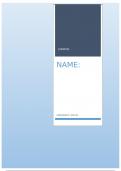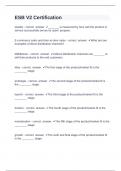HTHSCI 1H06 Human Anatomy and
Physiology I Midterm - Lecture guide Key
Terms & Concepts from 1-11 new approved
solution update McMaster University
, lOMoARcPSD|6353920
Key Terms & Concepts
Human Anatomy and Physiology, HTHSCI 1H06A,
F2018
You should be able to describe and/or demonstrate an understanding of the following:
*this is not an exhaustive list…
01 - Anatomical Terminology
• **Definition of Anatomy vs Physiology
o Anatomy – to take apart, the study of physical structures
o Physiology – study of natural phenomena, the function of structures
• Levels of Organization
o Molecular
o Cellular
o Tissue
o Organ
o System
• **Tissue types (4)
o Epithelial
• Acts in covering and lining
• Classified according to cell number and shape
o Number
▪ Simple – single layer
▪ Stratified – multiple layers
o Shape
▪ Squamous – flat shape
▪ Cuboidal – cubed shape
▪ Columnar – tall, skinny shape
o Connective
• Acts as binding and support
• Serves several functions:
o Binding and support
o Protection against infection
o Tissue repair
o Insulation
• Consists of cells surrounded by extra-cellular matrix (ECM)
o ECM = ground substances (i.e. fluid, semi-fluid, gelatinous or calcified) +
fibers (e.g. collagen, elastin, etc.)
• There are four classes of connective tissue:
o Connective Tissue
▪ Loose connective tissue (i.e. areolar, reticular and adipose)
▪ Dense connective tissue (i.e. regular, irregular, and elastic)
o Cartilage
, lOMoARcPSD|6353920
▪ Hyaline, fibrocartilage, and elastic
o Bone
o Blood
o Muscle
• Acts in movement
• There are three types of muscle tissue:
o Smooth Muscle
▪ Smallest muscle tissue
▪ Found in the wall of hollow organs (e.g. GI tract, respiratory
trac, etc.)
▪ Not striated (due to irregular arrangements of
contractile filaments, haphazard)
▪ Involuntary contractions, regulated by the ANS
(autonomic), hormones, stretch and ions
o Cardiac Muscle
▪ Intermediate size (compared to smooth muscle and
skeletal muscle)
▪ Primary tissue of the heart
▪ Striated (regular arrangement of contractile filaments)
▪ Branched
▪ Individual heart muscle cells (cardiomyocytes) are joined by
intercalated discs, containing proteins that form
desmosomes
(helping to connect cardiomyocytes) and gap junctions (helping
to connect cardiomyocyte by allowing ions to move from cytosol
of one cardiomyocyte to another)
▪ Involuntary contractions, regulated by the ANS
(autonomic), hormones, stretch and ions
o Skeletal Muscle
▪ Voluntary contractions
• Responsible for all voluntary movements b/c
contractions are controlled by neurons of the
SNS
(somatic)
▪ Individual skeletal muscle cells may be termed muscle fibers
or myofibrils b/c they are large (up to 30 centimeters long),
potential for containing several hundred nuclei
Skeletal Cardiac Smooth
Muscle Muscle Muscle
Neurotransmitter • ACh (acetylcholine) • ACh (acetylcholine) • ACh (acetylcholine)
(slide 4 from • Norepinephrine • Norepinephrine
lecture) • Epinephrine
Receptors • Nicotinic • Muscarinic • Muscarinic
(β1)
Appearance • Striated • Striated • Smallest muscle tissue
• Multinucleated • Intercalated discs • No striations
• Cylindrical • 1-2 nuclei • Single nucleus
, lOMoARcPSD|6353920
• Peripheral nuclei • Branched • Single shaped
Location • MSK system • Heart wall • Hollow organs (e.g. GI tract,
• Attached to the respiratory tract, etc.)
skeleton by tendons • Lining blood vessels (able to
contract and expand as
needed)
Nervous Control • Voluntary • Involuntary • Involuntary
• Somatic nervous system • Autonomic nervous • Autonomic nervous system
system
o Nervous
• Acts in control
• Primarily comprised of two cells types:
▪ Neurons
o Differ in size, shape and function
o Most neurons consist of three basic parts:
1. Body/soma
2. Dendrites
▪ Short cellular process that serve to receive
inputs (signals) while axon serves to
conduct output (nerve impulses) to other
cells
3. Axon
▪ Glia
o Serve to support neurons by providing protection (e.g.
immune function, blood-brain barrier formation, etc.),
regulating neuronal growth, maturation and interconnection
• Appearance of RBC in Different Salt Solutions
o Hypertonic – high salt solution, blood cells appear to be “dried out”
▪ H₂O being pulled out of the cell
o Isotonic – 0.9% salt solution, blood cells appear normal donut shaped
▪ H₂O moving into and out of the cell
o Hypotonic – low salt solution, blood cells appear “inflated”
▪ H₂O flowing into the cell at a quick rate
• **Origin of Anatomical terms (Region, Shape, Function, Story, Discoverer)
o Region – femur, thigh (Latin origin)
o Shape – foramen magnum, big hole
o Function – flexor digitorum, flexes fingers
o Story – sartorius, “tailor”
o Discoverer – vein of Galen, Aelius Galenus
• **Anatomical position, Sectioning planes, Directions, Movements
o Anatomic Position – standing erect, face forward, toes forward, palms forward
o Sectioning Planes






